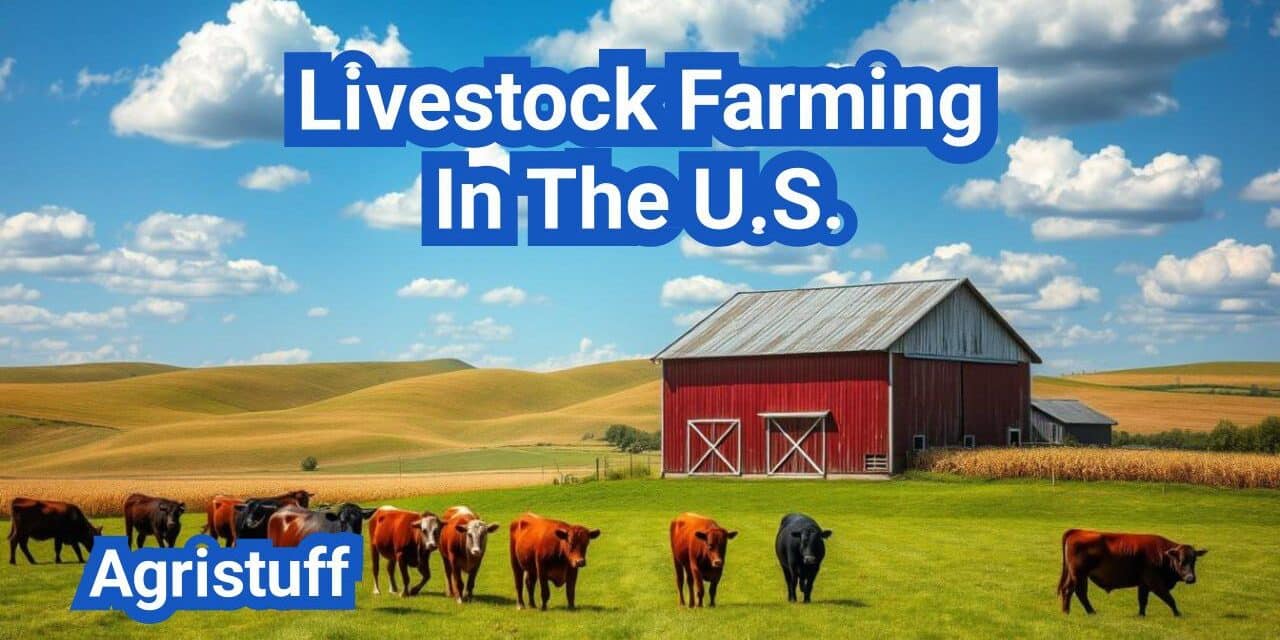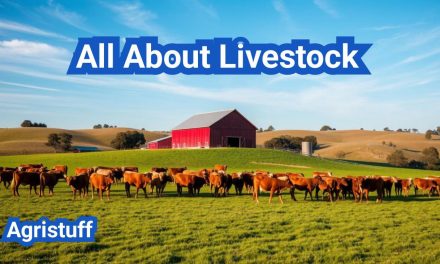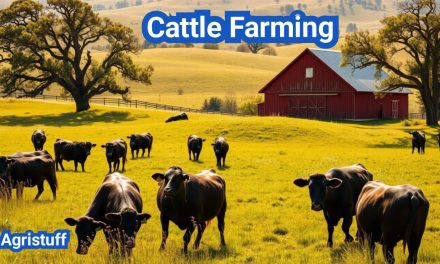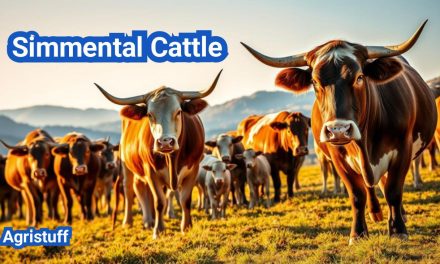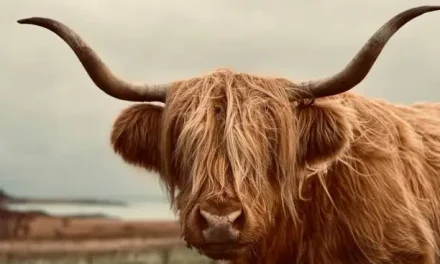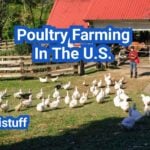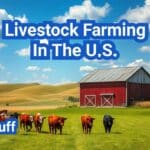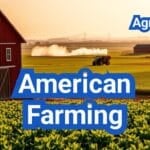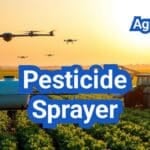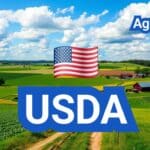Animal husbandry plays a vital role in the U.S. economy, with livestock farming being a significant contributor.
The industry has a rich history, dating back to the early days of American settlement. Today, it encompasses a wide range of activities, from cattle ranching to poultry production.
The impact of livestock farming extends beyond the economic sphere, influencing social structures and environmental conditions.
Key Takeaways
- The U.S. livestock industry is a significant economic driver.
- Animal husbandry practices vary across different regions.
- Environmental concerns are increasingly influencing farming practices.
- The industry is adapting to changing consumer demands.
- Technological advancements are improving farming efficiency.
The Current State of Livestock Farming In The U.S.
The U.S. livestock farming industry is a complex and multifaceted sector that plays a crucial role in the country’s agricultural economy. With a significant number of farms operating across the nation, the industry contributes substantially to the national economy and food production.
Key Statistics and Industry Overview
The U.S. is home to approximately 250,000 farms, with nearly 99 percent of farmed animals being raised on factory farms. This statistic highlights the dominance of industrial farming practices in the country. The livestock industry is a significant contributor to the U.S. economy, with livestock farming statistics indicating a substantial output in terms of meat, dairy, and other animal products.
Major Production Regions
The U.S. has several major livestock production regions. The Great Plains are known for cattle ranching, while the Midwest is a hub for swine and poultry production. The western states are also significant in livestock production, particularly for cattle. Understanding these major livestock regions is crucial for analyzing the industry’s overall performance and trends in U.S. livestock production.
These regions are critical to the nation’s livestock production, with each contributing to different aspects of the industry. The concentration of livestock farming in these areas is influenced by factors such as climate, feed availability, and market access.
Historical Development of American Livestock Farming

The development of livestock farming in the U.S. reflects broader agricultural trends, showcasing a significant transformation over the years. Livestock farming has been a cornerstone of American agriculture, evolving in response to technological advancements, market demands, and environmental considerations.
From Family Farms to Industrial Operations
The shift from family-owned farms to large industrial operations has been a defining characteristic of American livestock farming. Consolidation and specialization have driven this change, with many small farms being absorbed into larger entities. This transition has been influenced by economic factors, including the need for economies of scale to remain competitive.
“The family farm is a vital part of our agricultural heritage, but the reality is that many of these farms are being replaced by larger, more industrial operations.”
Technological Advancements in the Industry
Technological advancements have played a crucial role in shaping the livestock farming industry. Innovations in genetics, nutrition, and animal health have improved productivity and efficiency. For instance, the use of precision agriculture techniques has enabled farmers to monitor and manage their livestock more effectively.
| Technological Advancement | Impact on Livestock Farming |
|---|---|
| Precision Agriculture | Improved monitoring and management of livestock |
| Genetic Improvements | Enhanced productivity and disease resistance |
| Advanced Nutrition | Better feed formulation and animal health |
Types of Livestock Commonly Raised in the U.S.
The United States is home to a diverse range of livestock farming operations, with various types of animals being raised across the country. This diversity reflects the complexity and breadth of the American livestock industry.
Cattle (Beef and Dairy)
Cattle farming is a significant component of U.S. livestock production, encompassing both beef and dairy operations. Beef cattle are raised for meat production, while dairy cattle are managed for milk production.
Beef Cattle Breeds and Production Systems
Beef cattle breeds such as Angus and Hereford are popular in the U.S. due to their hardiness and meat quality. Production systems vary, with some operations focusing on grass-fed beef and others on grain-finishing.
Dairy Cattle Management
Dairy cattle management involves careful attention to nutrition, breeding, and milking practices. Holstein and Jersey are among the most common dairy breeds in the U.S.
Poultry (Chickens and Turkeys)
Poultry farming, particularly chicken and turkey production, is another major segment of the U.S. livestock industry. Chickens are the most consumed poultry, with over 9 billion chickens killed for meat every year in the U.S.
Other Livestock (Sheep, Goats, etc.)
Other livestock, including sheep farming and goats farming, are raised for meat, wool, and dairy products. These animals are often managed in smaller, specialized operations.
Farming Systems and Production Methods

Farming systems in the U.S. livestock sector range from conventional to organic methods, each with its unique characteristics and implications for the industry.
Conventional/Industrial Farming
Conventional or industrial farming is the most prevalent method in the U.S., characterized by large-scale operations and a focus on efficiency and cost-effectiveness. This system often relies on advanced technology and standardized practices to maximize production.
Organic Livestock Production
Organic livestock production adheres to strict guidelines that prohibit the use of antibiotics, hormones, and genetically modified organisms (GMOs). This method is gaining popularity due to consumer demand for organic products.
Free-Range and Pasture-Based Systems
Free-range and pasture-based systems allow animals to roam outdoors, promoting animal welfare and potentially improving the nutritional quality of the products. These systems are often associated with higher production costs but can offer premium pricing due to consumer preferences for humanely raised livestock.
Integrated Livestock-Crop Systems
Integrated livestock-crop systems involve combining livestock farming with crop production, enhancing biodiversity and potentially improving soil health. This holistic approach can lead to more sustainable farming practices.
By understanding these different farming systems, stakeholders can make informed decisions about livestock production methods that balance efficiency, sustainability, and consumer preferences.
How to Start a Livestock Farm: Step-by-Step Guide
The journey to establishing a thriving livestock farm begins with a well-structured plan and a clear understanding of the challenges involved. Aspiring farmers must consider several key factors to ensure the success of their operation.
Researching and Selecting Your Livestock Type
Choosing the right type of livestock is crucial for the success of your farm. Consider factors such as market demand, climate suitability, and your own experience or expertise. Research different breeds and their specific needs to make an informed decision.
Creating a Business Plan
A comprehensive business plan is essential for any livestock farming venture. It should outline your goals, production methods, marketing strategies, and financial projections.
Financial Projections
Develop detailed financial projections, including startup costs, ongoing expenses, and revenue forecasts. This will help you secure funding and make informed decisions about your operation.
Marketing Strategy
Outline your marketing strategy, including how you will reach potential customers and differentiate your products from competitors. Consider direct-to-consumer sales, partnerships with local businesses, or other marketing channels.
Securing Land and Facilities
Once you have a business plan in place, you’ll need to secure suitable land and facilities for your livestock. Consider factors such as soil quality, water availability, and zoning regulations.
Obtaining Necessary Permits and Licenses
Research and obtain all necessary permits and licenses to operate a livestock farm in your area. This may include environmental permits, health department permits, and other local or state regulations.
Essential Infrastructure for Livestock Operations

The backbone of any livestock operation is its infrastructure, which includes housing, fencing, and water systems. A well-designed infrastructure is crucial for maintaining animal health, ensuring operational efficiency, and promoting overall productivity.
Housing and Shelter Requirements
Proper housing is vital for protecting livestock from extreme weather conditions and predators. Animal shelters should be designed to provide adequate ventilation, insulation, and space for the animals to move comfortably. The type of housing required varies depending on the species and production system.
Fencing and Containment Systems
Effective fencing is necessary to contain livestock within designated areas and prevent escape or predation. Fencing materials and designs vary based on the type of livestock and the terrain of the farm. For instance, cattle farms often require robust fencing to prevent breaches.
Water Systems and Feed Storage
A reliable water system is essential for providing livestock with clean drinking water at all times. Additionally, proper feed storage facilities are necessary to maintain feed quality and prevent spoilage. The design of these systems should consider factors like water quality, accessibility, and capacity.
| Infrastructure Component | Purpose | Key Considerations |
|---|---|---|
| Animal Housing | Protects animals from weather and predators | Ventilation, insulation, space |
| Fencing | Contains livestock and prevents predation | Material, design, durability |
| Water Systems | Provides clean drinking water | Water quality, accessibility, capacity |
Day-to-Day Management of Livestock Farming In The U.S.

In the U.S., livestock farming demands a comprehensive approach to daily management, encompassing feeding, health monitoring, and breeding. Effective day-to-day management is crucial for maintaining the health and productivity of livestock, as well as ensuring the overall sustainability of the farm.
Feeding Protocols and Nutrition Management
Proper feeding protocols are essential for the nutritional well-being of livestock. This involves formulating diets that meet the specific nutritional needs of different animal species and production stages. Nutrition management also includes monitoring feed quality and ensuring that feeding systems are efficient and minimize waste.
Health Monitoring and Veterinary Care
Regular health monitoring is vital for early detection of diseases and parasites. This includes visual inspections, health records analysis, and working closely with veterinarians to implement preventive measures and treatments as needed. Effective health monitoring helps in reducing the risk of disease outbreaks and maintaining animal welfare.
Breeding Programs and Reproduction Management
Breeding programs are designed to improve the genetic quality of livestock, enhancing traits such as growth rate, milk production, and disease resistance. Reproduction management involves monitoring reproductive cycles, managing breeding records, and using technologies like artificial insemination to achieve optimal breeding outcomes.
Record Keeping Systems
Accurate record keeping is fundamental to the successful management of livestock farms. Records include feeding schedules, health treatments, breeding data, and production metrics. These records help farmers make informed decisions, identify areas for improvement, and comply with regulatory requirements.
| Management Aspect | Description | Importance |
|---|---|---|
| Feeding Protocols | Formulating diets for nutritional needs | High |
| Health Monitoring | Regular checks for disease and parasites | High |
| Breeding Programs | Improving genetic quality | Medium |
| Record Keeping | Maintaining accurate farm records | High |
Regulations and Compliance Requirements

Livestock farming in the U.S. is subject to a complex array of regulations that govern various aspects of the industry. These regulations are crucial for ensuring animal welfare, environmental protection, and public health.
Federal Regulations
The livestock industry is governed by several federal agencies, including the USDA, FDA, and EPA. The USDA’s Animal and Plant Health Inspection Service (APHIS) plays a key role in regulating animal health and welfare, while the FDA oversees feed safety and the EPA regulates environmental impacts. For instance, the USDA’s regulations on humane handling and care of animals are stringent, requiring farmers to adhere to specific guidelines to avoid penalties.
State and Local Regulations
In addition to federal regulations, livestock farmers must comply with state and local laws. These can include zoning restrictions, environmental regulations, and health codes. State regulations may vary significantly, so farmers must be aware of the specific requirements in their area. For example, some states have laws governing the minimum space requirements for animals, which can impact farming practices.
Animal Welfare Standards and Certification Programs
Animal welfare is a growing concern in the livestock industry, with various certification programs available to farmers who meet certain standards. Programs like the Certified Humane or Animal Welfare Approved offer consumers assurance that the products they purchase come from farms with high animal welfare standards. These programs not only enhance consumer trust but also promote better farming practices.
By understanding and complying with these regulations, livestock farmers can ensure their operations are both legally compliant and ethically sound.
Financial Management for Livestock Farmers

The backbone of a successful livestock farming operation is robust financial management. Livestock farmers face unique financial challenges, from managing operating costs to implementing effective pricing strategies. Understanding these elements is crucial for maintaining profitability and ensuring the long-term sustainability of the farm.
Understanding Operating Costs
Operating costs for livestock farmers include feed, veterinary care, equipment maintenance, and labor. Efficient management of these costs is vital. For instance, farmers can reduce feed costs by optimizing pasture use or negotiating better prices with suppliers. Regular maintenance of equipment can also prevent costly repairs down the line.
Pricing Strategies for Profitability
Developing effective pricing strategies is critical for livestock farmers to remain competitive while ensuring profitability. Farmers must consider market demand, production costs, and competitor pricing when setting prices for their products. Diversifying revenue streams, such as through value-added products or agritourism, can also enhance profitability.
Risk Management and Insurance
Risk management is a key aspect of financial management in livestock farming. Farmers face risks such as disease outbreaks, weather events, and market fluctuations. Insurance products can mitigate some of these risks, providing financial protection against unforeseen events. Diversifying livestock species and implementing biosecurity measures are also effective risk management strategies.
By focusing on these financial management practices, livestock farmers can improve their resilience and profitability in a challenging agricultural landscape.
Marketing and Selling Your Livestock Products

To stand out in the competitive livestock market, farmers must develop robust marketing plans. Effective marketing strategies enable farmers to reach potential buyers and differentiate their products from others in the market.
Direct-to-Consumer Sales Channels
Direct-to-consumer sales channels offer farmers a way to sell their products directly to end-users, potentially increasing profit margins. Popular direct-to-consumer sales methods include:
- Farmers’ markets
- Community Supported Agriculture (CSA) programs
- Online sales platforms
- On-farm stores or pick-your-own operations
Working with Processors, Auctions, and Distributors
Farmers can also sell their livestock products through various industry partners. This includes working with processors to create value-added products, participating in auctions to sell livestock directly, and partnering with distributors to reach broader markets.
| Sales Channel | Advantages | Challenges |
|---|---|---|
| Processors | Value-added products, steady demand | Quality control, pricing negotiations |
| Auctions | Competitive pricing, wide reach | Price volatility, commission fees |
| Distributors | Broad market access, logistical support | Margin compression, contractual obligations |
Building a Brand and Online Presence
Establishing a strong brand and online presence is crucial for differentiating products and engaging with consumers. This involves creating a professional website, leveraging social media, and implementing digital marketing strategies.
As noted by agricultural marketing expert, “A strong online presence can significantly enhance a farm’s visibility and customer engagement.” Building a brand requires consistent effort but can lead to customer loyalty and increased sales.
Sustainable Practices in Modern Livestock Farming

Sustainable livestock farming practices are becoming increasingly important in modern agriculture. As the industry continues to evolve, farmers are adopting more environmentally friendly methods to reduce their ecological footprint.
One effective approach is rotational grazing, which involves moving livestock to different areas of pasture to allow the land to recover. This practice not only improves soil health but also increases biodiversity and reduces the need for external feed sources.
Implementing Rotational Grazing
Rotational grazing is a simple yet effective method for improving pasture health. By dividing pastures into smaller sections and rotating livestock through them, farmers can maintain healthy vegetation cover and reduce erosion. As Rodney Martin, a livestock farmer, notes, “Rotational grazing has significantly improved the health of our pastures and reduced our operational costs.”
Waste Management and Composting Systems
Effective waste management is crucial in sustainable livestock farming. Composting systems can turn waste into valuable resources, such as fertilizer for crops. This approach not only reduces waste but also creates a valuable by-product that can enhance soil fertility.
Reducing Environmental Impact
Livestock farming can have significant environmental impacts, including greenhouse gas emissions and water pollution. By adopting sustainable practices like rotational grazing and waste management, farmers can reduce their environmental footprint. As the National Cattlemen’s Beef Association states, “Sustainable beef production is about producing high-quality beef while protecting the environment and conserving natural resources for future generations.”
Technology and Innovation in Livestock Production

Technological advancements are revolutionizing livestock production, enhancing efficiency and productivity. The integration of technology in livestock farming has led to improved animal welfare, reduced environmental impact, and increased profitability for farmers.
Precision Livestock Farming Tools
Precision livestock farming involves the use of advanced technology to monitor and manage livestock. This includes monitoring systems that track animal health and behavior, enabling early detection of diseases.
Monitoring Systems
These systems use sensors and wearable devices to monitor livestock health and behavior in real-time, allowing farmers to make data-driven decisions.
Automated Feeding Equipment
Automated feeding systems optimize feed distribution, reducing waste and improving the nutritional intake of livestock.
Data Management Software
Effective data management is crucial in modern livestock production. Software solutions help farmers organize and analyze data on animal health, breeding, and nutrition, leading to more informed decision-making.
Emerging Technologies for Small and Large Operations
Emerging technologies such as artificial intelligence, blockchain, and the Internet of Things (IoT) are being adopted in livestock farming. These technologies offer opportunities for improved efficiency, transparency, and sustainability across both small and large-scale operations.
Overcoming Common Challenges in Livestock Farming
The livestock farming industry encounters various obstacles that require effective management strategies. These challenges can significantly impact the productivity and profitability of farming operations.
Disease Prevention and Management
Disease prevention is crucial in livestock farming. Implementing biosecurity measures, such as vaccination programs and quarantine protocols, can help mitigate the risk of disease outbreaks. Regular health monitoring and veterinary care are also essential for early detection and treatment.
| Disease Prevention Measure | Description | Benefits |
|---|---|---|
| Vaccination Programs | Administering vaccines to livestock to build immunity against specific diseases. | Reduces disease incidence, promotes animal health. |
| Quarantine Protocols | Isolating new or sick animals to prevent disease spread. | Contains outbreaks, protects healthy animals. |
Dealing with Weather Extremes and Climate Change
Livestock farmers must adapt to weather extremes and the long-term effects of climate change. Strategies include providing shelter and ventilation, using climate-resilient breeds, and implementing rotational grazing to manage pasture health.
Labor Management and Workforce Development
Effective labor management is vital for the success of livestock farming operations. This includes training staff on animal care and welfare, as well as adopting technologies that improve efficiency and reduce labor requirements.
Government Programs and Resources for Livestock Farmers
Livestock farming in the U.S. is supported by a range of government programs and resources designed to promote the success and sustainability of agricultural operations.
The United States Department of Agriculture (USDA) plays a pivotal role in providing financial and technical assistance to livestock farmers. Key initiatives include financial support through loans, grants, and subsidies.
USDA Loans, Grants, and Subsidies
The USDA offers various financial assistance programs, including:
- Direct loans for farm operating expenses
- Loan guarantees for commercial lenders
- Grants for beginning farmers and ranchers
- Disaster relief programs
These programs help farmers manage risks, improve their operations, and increase profitability.
Extension Services and Educational Opportunities
USDA’s National Institute of Food and Agriculture (NIFA) supports agricultural research, education, and extension programs. Livestock farmers can benefit from:
- Expert advice on best practices
- Workshops and training programs
- Access to the latest research and technology
By leveraging these government programs and resources, livestock farmers can enhance their operations, improve efficiency, and contribute to the overall sustainability of the agricultural sector.
Diversification Strategies for Livestock Operations
Diversifying livestock operations can significantly enhance profitability and sustainability. By expanding their revenue streams, farmers can reduce their dependence on a single product or market, thereby mitigating risks associated with market fluctuations and environmental challenges.
Value-Added Products
Creating value-added products is a lucrative diversification strategy. This involves processing raw livestock products into goods that command higher prices in the market. Examples include artisanal cheeses, organic meats, and specialty wool products. By adding value, farmers can tap into niche markets and increase their profit margins.
Agritourism Opportunities
Agritourism offers another viable path for diversification. By opening their farms to visitors, livestock operators can generate additional income through tours, workshops, and on-farm accommodations. This not only provides a new revenue stream but also helps educate the public about livestock farming practices.
Multiple Species Integration
Integrating multiple species into a farming operation can enhance biodiversity and improve farm resilience. This approach involves raising different types of livestock together, such as cattle and sheep, or combining livestock with crop production. It can lead to more efficient use of resources and reduced environmental impact.
At The End of: Livestock Farming In The U.S.
Livestock farming is a significant sector in the United States, contributing substantially to the country’s agricultural output and economy. This article has explored the various aspects of livestock farming, from its historical development to current practices and future prospects.
The industry encompasses a wide range of activities, including cattle, poultry, swine, and other livestock production. Understanding the different farming systems, such as conventional, organic, and free-range, is crucial for appreciating the complexity of livestock farming.
Key factors such as infrastructure, day-to-day management, regulations, and financial management play critical roles in the success of livestock operations. The adoption of technology and innovative practices is also transforming the industry, enhancing efficiency and sustainability.
In conclusion, livestock farming in the U.S. is a multifaceted industry that requires careful planning, management, and adherence to regulations. By summarizing the key points discussed, this article provides a livestock farming summary, highlighting the importance of this sector and the various elements that contribute to its success.
FAQ
What is the current state of livestock farming in the U.S.?
The current state of livestock farming in the U.S. is characterized by a mix of small, medium, and large-scale operations, with a growing trend towards more industrialized and technologically advanced farming practices.
What are the major production regions for livestock in the U.S.?
The major production regions for livestock in the U.S. include the Great Plains, the Midwest, and parts of the South, where cattle, poultry, and swine are commonly raised.
How has livestock farming evolved historically in the U.S.?
Livestock farming in the U.S. has evolved from small family farms to larger industrial operations, driven by technological advancements, changes in consumer demand, and economic pressures.
What types of livestock are commonly raised in the U.S.?
Cattle, poultry, swine, sheep, and goats are among the most common types of livestock raised in the U.S., with varying production systems and management practices.
What are the different farming systems used in livestock production?
Livestock farming systems in the U.S. include conventional, organic, free-range, and integrated systems, each with its own advantages and disadvantages.
How do I start a livestock farm?
Starting a livestock farm requires researching and selecting the right livestock, creating a comprehensive business plan, securing land and facilities, and obtaining necessary permits and licenses.
What infrastructure is essential for livestock operations?
Essential infrastructure for livestock operations includes housing and shelter, fencing and containment systems, and water systems and feed storage.
How do I manage my livestock farm on a day-to-day basis?
Day-to-day management of a livestock farm involves feeding protocols, health monitoring, breeding programs, and record-keeping systems.
What regulations and compliance requirements apply to livestock farming?
Livestock farming is subject to federal, state, and local regulations, including animal welfare standards and certification programs.
How can I manage the finances of my livestock farm?
Financial management for livestock farmers involves understanding operating costs, pricing strategies, and risk management, as well as exploring government programs and resources.
What are some sustainable practices in modern livestock farming?
Sustainable practices in livestock farming include rotational grazing, waste management, and reducing environmental impact.
How is technology transforming livestock production?
Technology is transforming livestock production through precision farming tools, data management software, and emerging technologies that improve efficiency and productivity.
What are some common challenges in livestock farming, and how can they be overcome?
Common challenges in livestock farming include disease prevention, managing weather extremes, and labor management, which can be addressed through best management practices, risk management strategies, and government support.
What government programs and resources are available to support livestock farmers?
Government programs and resources available to support livestock farmers include USDA loans, grants, and subsidies, as well as extension services and educational opportunities.
How can I diversify my livestock operation?
Diversification strategies for livestock operations include creating value-added products, exploring agritourism opportunities, and integrating multiple species.
Conclusion of: Livestock Farming In USA
What Livestock Farming In The U.S. means
Livestock Farming In The U.S. refers to the organized production of cattle, hogs, poultry, sheep, goats, and related species for meat, milk, eggs, and by-products, supported by inputs like feed, veterinary services, transport, processing, and retail. Operators rely on official statistics, baseline definitions, and regular market updates to plan capacity, evaluate risk, and benchmark performance across regions and seasons in Livestock Farming In The U.S. USDA Economic Research Service – Animal Products Topic Hub
The scale and structure of Livestock Farming In The U.S.
Livestock Farming In The U.S. spans small family ranches to large, integrated systems that coordinate genetics, feed, animal health, and downstream processing under contracts and cooperatives. Understanding how farms, feedlots, packers, renderers, and retailers fit together helps producers capture value, manage margins, and comply with rules shaping Livestock Farming In The U.S. USDA ERS – Reports on livestock markets and structure
Regional patterns within Livestock Farming In The U.S.
Livestock Farming In The U.S. is regionally concentrated: beef cow–calf herds thrive where rangeland and pasture dominate, feedlots cluster near grain in the Plains, dairy anchors in the Upper Midwest and West, and poultry integrates across the Southeast. Weather, water, land use, and transport costs help explain the map of Livestock Farming In The U.S. USDA NASS – Cattle Maps & Charts
Economics that drive Livestock Farming In The U.S.
Margins in Livestock Farming In The U.S. reflect feed prices, calf and feeder availability, carcass yields, packer capacity, labor, energy, and consumer demand at home and abroad. Producers track monthly outlooks, slaughter, price spreads, and retail features to time placements and sales across Livestock Farming In The U.S. USDA ERS – Livestock, Dairy, & Poultry Outlook
Beef cattle in Livestock Farming In The U.S.
Beef-focused Livestock Farming In The U.S. typically starts with cow–calf herds producing weaned calves that move to stocker/backgrounding and then into feedlots for finishing, before harvest and fabrication. Inventory, calf crops, and heifer retention cycles matter to long-run beef supply in Livestock Farming In The U.S. USDA NASS – Cattle Survey & Reports
Dairy’s role in Livestock Farming In The U.S.
Dairy within Livestock Farming In The U.S. produces fluid milk and ingredients like cheese, butter, whey, and milk powders, with economics shaped by milk yield per cow, feed costs, California and Federal Orders, and processing capacity. Market outlooks and data tools inform herd and investment plans across Livestock Farming In The U.S. USDA ERS – Dairy Market Outlook
Hogs and pork in Livestock Farming In The U.S.
Swine production in Livestock Farming In The U.S. ranges from farrow-to-finish to specialized farrowing, nursery, and finisher sites under coordinated systems. Biosecurity, genetics, and feed conversion are major profit levers that influence cost curves throughout Livestock Farming In The U.S. USDA NASS – Hogs & Pigs Reports
Poultry integration in Livestock Farming In The U.S.
Broiler and turkey operations in Livestock Farming In The U.S. are largely contract-integrated, with companies supplying chicks, feed, and vet care, and growers managing houses and labor to meet performance targets. Litter management, energy efficiency, and ventilation are central to margins in Livestock Farming In The U.S. USDA ERS – Poultry & Eggs
Small ruminants and niche markets in Livestock Farming In The U.S.
Sheep and goats contribute specialty meats, milk, and fiber to Livestock Farming In The U.S., often serving ethnic, premium, or local markets where seasonality and carcass specs matter. Targeted grazing and diversified enterprises can stabilize income streams within Livestock Farming In The U.S. USDA NASS – Sheep & Goats
Feed and forage underpin Livestock Farming In The U.S.
Feed grains, co-products, hay, and pasture quality determine performance in Livestock Farming In The U.S., linking crop yields, ethanol by-products, hay stocks, and drought to average daily gain and milk per cow. Forage planning and feed testing are routine risk controls across Livestock Farming In The U.S. USDA ERS – Corn (feed market context)
Animal health and biosecurity across Livestock Farming In The U.S.
Strong biosecurity plans protect Livestock Farming In The U.S. from high-impact diseases, using controlled access points, truck and equipment sanitation, pest control, isolation pens, and vaccination programs where applicable. State and federal partners publish disease alerts that guide response in Livestock Farming In The U.S. USDA APHIS – Animal Health
Antibiotic stewardship rules shaping Livestock Farming In The U.S.
Antimicrobial use in Livestock Farming In The U.S. follows federal stewardship: medically important antibiotics in feed require a veterinarian’s authorization under the Veterinary Feed Directive, and many formerly over-the-counter products now require prescriptions to support responsible use in Livestock Farming In The U.S. FDA – Veterinary Feed Directive (VFD)
Traceability and movement in Livestock Farming In The U.S.
Moving covered cattle and bison across state lines in Livestock Farming In The U.S. generally requires official identification and health certificates; traceability initiatives help shorten investigations, protect markets, and speed recovery after outbreaks. Producers should review current ID and paperwork rules for Livestock Farming In The U.S. USDA APHIS – Animal Disease Traceability
Food safety oversight within Livestock Farming In The U.S.
Meat, poultry, and processed egg products from Livestock Farming In The U.S. are inspected by USDA’s Food Safety and Inspection Service to ensure they are safe, wholesome, and properly labeled, with preventive controls and humane handling enforced at plants that serve Livestock Farming In The U.S. USDA FSIS – Food Safety
Public-health partners supporting Livestock Farming In The U.S.
When illnesses occur, CDC collaborates with FSIS and FDA to investigate outbreaks linked to foods from Livestock Farming In The U.S., translating surveillance into interventions that reduce risk along the supply chain and protect consumers served by Livestock Farming In The U.S. CDC – What CDC Is Doing About Food Safety
Labeling rules that affect Livestock Farming In The U.S.
Marketing claims and product identity statements must follow federal rules in Livestock Farming In The U.S.; for example, FSIS has tightened criteria for voluntary “Product of USA” claims so labels match consumer expectations and reduce confusion throughout Livestock Farming In The U.S. USDA FSIS – Labeling Policies
Grading and marketing signals in Livestock Farming In The U.S.
Voluntary USDA grades translate carcass traits into market signals in Livestock Farming In The U.S., such as Prime, Choice, and Select for beef and official egg grades for shell eggs, helping sellers and buyers align specs, premiums, and programs across Livestock Farming In The U.S. USDA AMS – Grades & Standards
Environmental compliance in Livestock Farming In The U.S.
Large animal feeding operations in Livestock Farming In The U.S. may require Clean Water Act permits covering process wastewater and storm water; nutrient plans, land-application limits, and recordkeeping demonstrate control and protect watersheds connected to Livestock Farming In The U.S. EPA – AFO/CAFO & NPDES Overview
Manure and nutrient planning for Livestock Farming In The U.S.
Comprehensive Nutrient Management Plans align storage, transfer, and agronomic application for Livestock Farming In The U.S., improving soil health, reducing runoff, and converting manure into fertilizer value under engineering and conservation standards commonly applied in Livestock Farming In The U.S. USDA NRCS – Manure & Nutrient Management
Infrastructure standards that support Livestock Farming In The U.S.
Designing pits, tanks, and lagoons for Livestock Farming In The U.S. typically follows NRCS conservation practice standards that address siting, linings, volumes, and safety, providing consistent engineering baselines for projects across Livestock Farming In The U.S. USDA NRCS – Waste Storage Facility (Code 313)
Greenhouse gases and sustainability in Livestock Farming In The U.S.
Enteric methane, manure methane, and nitrous oxide are key emissions linked to Livestock Farming In The U.S.; mitigation options include diet adjustments, anaerobic digestion, covered lagoons, and improved manure handling that can enhance sustainability efforts throughout Livestock Farming In The U.S. EPA – U.S. Greenhouse Gas Emissions: Agriculture
Worker safety in Livestock Farming In The U.S.
Human safety is foundational to Livestock Farming In The U.S.; training for low-stress animal handling, confined-space protocols, respiratory protection around dust and gases, and machine guarding for augers and PTOs helps reduce injuries in operations across Livestock Farming In The U.S. CDC/NIOSH – Agriculture, Forestry, and Fishing Safety
Food-supply chain hygiene linked to Livestock Farming In The U.S.
Sanitation standard operating procedures, Hazard Analysis and Critical Control Points, and humane-handling compliance support plants serving Livestock Farming In The U.S.; understanding federal roles clarifies who regulates what from farm to table within Livestock Farming In The U.S. FoodSafety.gov – Who Regulates Food
Risk-management tools for Livestock Farming In The U.S.
Producers hedge downside price risk in Livestock Farming In The U.S. with federally backed insurance such as Livestock Risk Protection for feeder cattle, fed cattle, swine, and lamb, aligning indemnities to market indexes used widely in Livestock Farming In The U.S. USDA RMA – Livestock Risk Protection (LRP)
Margin tools for Livestock Farming In The U.S.
Some operators protect net returns in Livestock Farming In The U.S. through Livestock Gross Margin policies that incorporate projected feed and output prices, complementing on-exchange hedges and contracts used to stabilize cash flow in Livestock Farming In The U.S. USDA RMA – Livestock Gross Margin (LGM)
Finance and credit access in Livestock Farming In The U.S.
Beginning and expanding producers in Livestock Farming In The U.S. can access microloans, operating loans, and ownership loans, plus disaster assistance and conservation programs that reduce capital barriers and smooth volatility in Livestock Farming In The U.S. USDA Farmers.gov – Beginning Farmers & Ranchers
Compliance checklists that touch Livestock Farming In The U.S.
Depending on size and activities, Livestock Farming In The U.S. intersects with state veterinarians, environmental agencies, conservation districts, and workplace safety rules; building a compliance calendar prevents surprises and aligns audits for facilities within Livestock Farming In The U.S. OSHA – Agriculture Industry Safety & Health
Trade and global markets for Livestock Farming In The U.S.
Exports and imports shape prices and demand for Livestock Farming In The U.S.; monthly trade tables by species and partner country help producers anticipate shifts and make marketing decisions tied to global flows that influence Livestock Farming In The U.S. USDA ERS – Livestock & Meat International Trade Data
Data habits that strengthen Livestock Farming In The U.S.
Strong operators in Livestock Farming In The U.S. maintain dashboards that track inventories, slaughter, prices, feed costs, retail features, and weather, using official data products and downloadable spreadsheets that update frequently for continuous decision support in Livestock Farming In The U.S. USDA ERS – Data Products (Livestock & Dairy)
Final thought
Winning strategies in Livestock Farming In The U.S. blend animal health, biosecurity, humane handling, environmental stewardship, savvy hedging, and strict compliance—paired with disciplined use of public data and technical standards—so each season compounds skills, resilience, and market access across Livestock Farming In The U.S. USDA Farmers.gov – Programs, Help, and Tools
Sources & References
- USDA ERS – Animal Products
- USDA ERS – Dairy Market Outlook
- USDA ERS – Poultry & Eggs
- USDA APHIS – Animal Health
- FDA – Veterinary Feed Directive
- USDA APHIS – Animal Disease Traceability
- USDA FSIS – Food Safety
- CDC – Food Safety: What CDC Is Doing
- USDA AMS – Grades & Standards
- EPA – AFO/CAFO & NPDES Overview
- USDA NRCS – Manure & Nutrient Management
- USDA NRCS – Waste Storage Facility (Code 313)
- CDC/NIOSH – Agriculture Worker Safety
- FoodSafety.gov – Who Regulates Food
- USDA Farmers.gov – Beginning Farmers & Ranchers
- OSHA – Agriculture Industry
- USDA ERS – Livestock & Meat International Trade Data
- USDA ERS – Data Products
- USDA Farmers.gov – Programs & Tools

